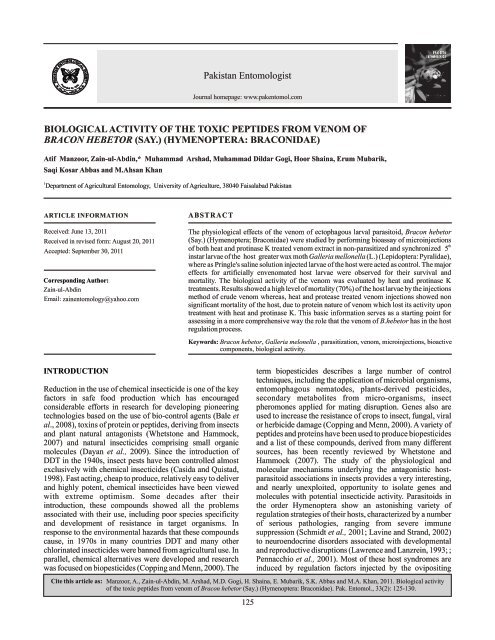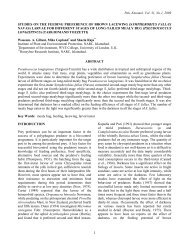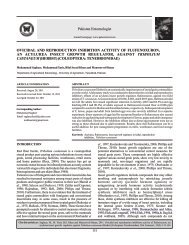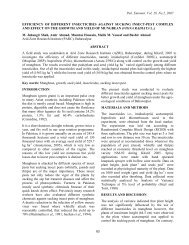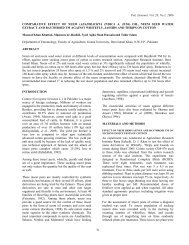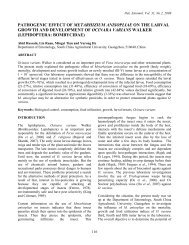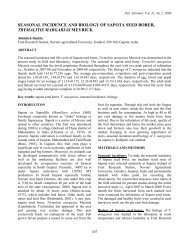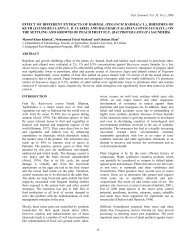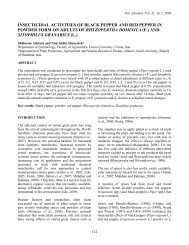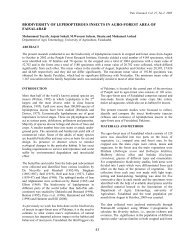Entomol. Journal Page Setting, all articles - Pakistan Entomologist
Entomol. Journal Page Setting, all articles - Pakistan Entomologist
Entomol. Journal Page Setting, all articles - Pakistan Entomologist
Create successful ePaper yourself
Turn your PDF publications into a flip-book with our unique Google optimized e-Paper software.
<strong>Pakistan</strong> <strong>Entomol</strong>ogist<br />
<strong>Journal</strong> homepage: www.pakentomol.com<br />
BIOLOGICAL ACTIVITY OF THE TOXIC PEPTIDES FROM VENOM OF<br />
BRACON HEBETOR (SAY.) (HYMENOPTERA: BRACONIDAE)<br />
Atif Manzoor, Zain-ul-Abdin,* Muhammad Arshad, Muhammad Dildar Gogi, Hoor Shaina, Erum Mubarik,<br />
Saqi Kosar Abbas and M.Ahsan Khan<br />
1<br />
Department of Agricultural <strong>Entomol</strong>ogy, University of Agriculture, 38040 Faisalabad <strong>Pakistan</strong><br />
ARTICLE INFORMATION<br />
Received: June 13, 2011<br />
Received in revised form: August 20, 2011<br />
Accepted: September 30, 2011<br />
Corresponding Author:<br />
Zain-ul-Abdin<br />
Email: zainentomology@yahoo.com<br />
ABSTRACT<br />
The physiological effects of the venom of ectophagous larval parasitoid, Bracon hebetor<br />
(Say.) (Hymenoptera; Braconidae) were studied by performing bioassay of microinjections<br />
th<br />
of both heat and protinase K treated venom extract in non-parasitized and synchronized 5<br />
instar larvae of the host greater wax moth G<strong>all</strong>eria mellonella (L.) (Lepidoptera: Pyralidae),<br />
where as Pringle's saline solution injected larvae of the host were acted as control. The major<br />
effects for artifici<strong>all</strong>y envenomated host larvae were observed for their survival and<br />
mortality. The biological activity of the venom was evaluated by heat and protinase K<br />
treatments. Results showed a high level of mortality (70%) of the host larvae by the injections<br />
method of crude venom whereas, heat and protease treated venom injections showed non<br />
significant mortality of the host, due to protein nature of venom which lost its activity upon<br />
treatment with heat and protinase K. This basic information serves as a starting point for<br />
assessing in a more comprehensive way the role that the venom of B.hebetor has in the host<br />
regulation process.<br />
Keywords: Bracon hebetor, G<strong>all</strong>eria melonella , parasitization, venom, microinjections, bioactive<br />
components, biological activity.<br />
INTRODUCTION<br />
term biopesticides describes a large number of control<br />
techniques, including the application of microbial organisms,<br />
Reduction in the use of chemical insecticide is one of the key entomophagous nematodes, plants-derived pesticides,<br />
factors in safe food production which has encouraged secondary metabolites from micro-organisms, insect<br />
considerable efforts in research for developing pioneering pheromones applied for mating disruption. Genes also are<br />
technologies based on the use of bio-control agents (Bale et used to increase the resistance of crops to insect, fungal, viral<br />
al., 2008), toxins of protein or peptides, deriving from insects or herbicide damage (Copping and Menn, 2000). A variety of<br />
and plant natural antagonists (Whetstone and Hammock, peptides and proteins have been used to produce biopesticides<br />
2007) and natural insecticides comprising sm<strong>all</strong> organic and a list of these compounds, derived from many different<br />
molecules (Dayan et al., 2009). Since the introduction of sources, has been recently reviewed by Whetstone and<br />
DDT in the 1940s, insect pests have been controlled almost Hammock (2007). The study of the physiological and<br />
exclusively with chemical insecticides (Casida and Quistad, molecular mechanisms underlying the antagonistic host-<br />
1998). Fast acting, cheap to produce, relatively easy to deliver parasitoid associations in insects provides a very interesting,<br />
and highly potent, chemical insecticides have been viewed and nearly unexploited, opportunity to isolate genes and<br />
with extreme optimism. Some decades after their molecules with potential insecticide activity. Parasitoids in<br />
introduction, these compounds showed <strong>all</strong> the problems the order Hymenoptera show an astonishing variety of<br />
associated with their use, including poor species specificity regulation strategies of their hosts, characterized by a number<br />
and development of resistance in target organisms. In of serious pathologies, ranging from severe immune<br />
response to the environmental hazards that these compounds suppression (Schmidt et al., 2001; Lavine and Strand, 2002)<br />
cause, in 1970s in many countries DDT and many other to neuroendocrine disorders associated with developmental<br />
chlorinated insecticides were banned from agricultural use. In and reproductive disruptions (Lawrence and Lanzrein, 1993; ;<br />
par<strong>all</strong>el, chemical alternatives were developed and research Pennacchio et al., 2001). Most of these host syndromes are<br />
was focused on biopesticides (Copping and Menn, 2000). The induced by regulation factors injected by the ovipositing<br />
Cite this article as:<br />
Manzoor, A., Zain-ul-Abdin, M. Arshad, M.D. Gogi, H. Shaina, E. Mubarik, S.K. Abbas and M.A. Khan, 2011. Biological activity<br />
of the toxic peptides from venom of Bracon hebetor (Say.) (Hymenoptera: Braconidae). Pak. <strong>Entomol</strong>., 33(2): 125-130.<br />
125
Manzoor et al. / <strong>Pakistan</strong> <strong>Entomol</strong>ogist 2011, 33(2): 125-130<br />
parasitoid female, such as: venom and polydnaviruses needs, ecological adaptation and developmental<br />
(PDVs) (Pennacchio and Strand, 2006).<br />
characteristics. It is used as a host in favor of many<br />
hymenoptera species (Burges, 1978; Smith, 1965; Haewoon<br />
The parasitic form of life is very prolific and has evolved in<br />
et al., 1995; Coskun et al., 2006; Dweck et al., 2010;) The<br />
copious orders of arthropods. In parasitic insects adults are<br />
present study was carried out with the aim to evaluate the<br />
free living and a few numbers of progeny develop per host.<br />
biological activity of the venom of the wasp. .<br />
The hosts are not survived during the encounters so many<br />
parasitic insects are different from other parasitic organisms<br />
(Vinson, 1975).<br />
MATERIALS AND METHODS<br />
Regulation of host by insect parasitoids is a multifaceted<br />
procedure which consequences in a common physiological<br />
condition, ultimately increasing the suitability of the host<br />
Rearing of host parasitoid culture<br />
(Vinson and Iwantsch, 1981). According to their origin and<br />
The ectophagous larval parasitic wasp Bracon hebetor (Say.)<br />
function, there are different categories of host regulation<br />
(Hymenoptera: Braconidae) was reared under laboratory<br />
factors. Adult parasitoid females produce maternal origin<br />
th<br />
conditions on the mature larvae (5 instar) of greater wax<br />
factors that are injected at the time of oviposition, while<br />
moth G<strong>all</strong>eria mellonella (Lepidoptera: Pyralidae) by<br />
factors belonging to embryonic origin are obtained from the<br />
following a slightly modified approach as described by Alserosal<br />
membrane or from the other tissues associated with<br />
Tememi, 2005; Khan et al., 2005; Ahmed and Ahmad, 2006.<br />
embryo. Host physiology is also regulated by the parasitoid<br />
The adults of the parasitoid, B. hebetor were collected directly<br />
larvae.<br />
from fodder Trifolim alexandrium L., located at the campus of<br />
The host-parasitoid association that was considered in the the University of Agriculture, Faisalabad, <strong>Pakistan</strong>. The<br />
present study is Bracon hebetor (Say.) (Hymenoptera: collected parasitoids were identified on the basis of their<br />
Braconiodae) and G<strong>all</strong>eria mellonella (L.) (Lepidoptera: morphological characters. This parasitoid has two<br />
Pyralidae). Bracon hebetor (Say.) is a gregarious, phenotypes, depending on the temperature. During summer<br />
arrhenotokous, idiobiont, ectoparasitoid wasp, attacking the season, the adults have brownish colour while, during winter<br />
larvae of lepidopterons (Tuncyurek, 1972; Cline et al., 1984; season, the adults have blackish colour (Ahmed et al., 1985).<br />
Gul and Gulel 1995; Heimpel et al., 1997; Darwish et al., The larvae, pupae and adults of the host, G. mellonella were<br />
2003). It has been widely used in studies of host parasitoid collected from the infested bee hives located at the campus of<br />
interactions because of its high reproductive rate, short University of Agriculture, Faisalabad, <strong>Pakistan</strong>. The host and<br />
generation time and significant range of host species parasitoid cultures were maintained in two separate glass jars,<br />
o<br />
(Tuncyurek, 1972; Gul and Gulel, 1995). B. hebetor (Say) both were kept at 27-30 C±1, 65±5% temperature, relative<br />
completes its development on different species of humidity (RH) and 18 h light /6 h dark photoperiod.<br />
Lepidopteran larvae by using gener<strong>all</strong>y Pyralidae The culture of the parasitoid was reared on the larvae of the<br />
(Lepidoptera) larvae as host . Most of the species of Pyralidae greater wax moth G. mellonela as a host by using glass vials of<br />
(Lep.) are agricultural pests on some field and storage crops. (2×10 cm) in the insect molecular biology laboratory,<br />
Toxic bio-active peptides are present in the venom of the Department of Agri. <strong>Entomol</strong>ogy, University of Agriculture,<br />
th<br />
B.hebetor which blocks the neuromuscular transmissions in Faisalabad. Each vial contains 2 to 3 of to 5 instar larvae of<br />
larvae of lepidopteran species by inhibiting exocytosis of pre the host and one female of the parasitoid, provided with cotton<br />
synaptic vesicles (Piek, 1966; Walther and Reinecke, 1983). swabs/pads soaked in 50% honey and water as food source for<br />
Its females have a preference to attack last (fifth) instar of host adult of B. hebetor. The females of the parasitoid start to<br />
larvae (Benson, 1973). The host is first injected with venom parasitize the larvae of the host by first injecting a sm<strong>all</strong><br />
th<br />
that induces entire and everlasting paralysis within 15 quantity of paralyzing venom into mature (5 instar) larvae of<br />
minutes (Piek, 1966; Piek et al., 1974). After host-feeding, a the host before egg laying on them, which induces partial or<br />
female lays between 5 and 25 eggs per host depending upon complete paralysis and then deposit between 3 to 20 eggs on<br />
the size of the host, host-encounter pace, and physiological the outside of the host. After parasitism, the larvae of the host<br />
state of the ovipositing female (Benson, 1973; Hagstrum and become sluggish and later on, the females start egg laying on<br />
Smittle, 1977) . Females lay eggs on the host body and after these larvae. After 24 hours, the parasitized larvae of the host<br />
hatching the eggs, the larvae of the parasitoid produce silken were shifted from the vials to new sterilized glass jars (9×5<br />
cocoons and pupate outside the body of the host. Adult wasps cm) by using brush, provided with wax, pollen and honey as<br />
emerge from pupae ~16 days after oviposition.<br />
food for developing host larvae by keeping at the same<br />
The greater wax moth, G<strong>all</strong>eria mellonella (L.) (Lepidoptera: environmental conditions stated as above and the females of<br />
th<br />
Pyralidae) is an economic<strong>all</strong>y vital pest of the honeybee and is the parasitoid were shifted to new vials containing 2-3 (4-5<br />
one of the most devastating pests of wax in the world. Moth's instar) larvae of the host for further parasitization and this<br />
larval stages feed on wax, honey and pollen thus causing process remained continue until the last moment of the female<br />
serious economic damage as they tunnel through the comb. life. The eggs were hatched within 2-3 days into transparent<br />
The larvae of the wax moth, cause considerable damage to larvae, which were directly bored into the body of the host<br />
combs left unattended by bees (Caron, 1992). G. mellonella is larvae for feeding. These larvae, after completing their<br />
preferred in entomological studies, because of its nutritional feeding/development came out the host body for pupation.<br />
Cite this article as:<br />
Manzoor, A., Zain-ul-Abdin, M. Arshad, M.D. Gogi, H. Shaina, E. Mubarik, S.K. Abbas and M.A. Khan, 2011. Biological activity<br />
of the toxic peptides from venom of Bracon hebetor (Say.) (Hymenoptera: Braconidae). Pak. <strong>Entomol</strong>., 33(2): 125-130.<br />
126
Life cycle of the parasitoid ranged from 9 to 12 days, through micro injection bioassay. Injections of venom (Heat<br />
depending on the rearing conditions (Temperature and and protease treated) were performed on non-parasitized<br />
humidity). Fin<strong>all</strong>y, these pupae were collected singly in hosts, on day 1 fourth and fifth instars, which were<br />
glass vials plugged with cotton swab/pad soaked with 50% synchronized by following the approach as described by<br />
honey and water as food source upon emergence of Pennacchio et al. (1995). Experimental insects were<br />
naive/virgin parasitoid adults which were separated by anaesthetized by placing in refrigerator or on ice and<br />
sexes: morphologic<strong>all</strong>y the females were distinguished injections containing 0.5-µl aliquots of treated venom were<br />
from the males by their pointed/conical abdomen performed into the pronotum of the larvae as stated by Quistad<br />
(ovipositor). The collected parasitoids were frozen at et al., 1996 and by following a slightly modified protocol of<br />
−80°C.<br />
Digilio et al. (1998, 2000) by using a glass microcapillary<br />
Venom extraction<br />
tube with a very fine tip/Micro-sampling syringe, 0.5 µl<br />
BioBasics (Cat.No. SR.031). Host Larvae receiving saline<br />
Females of B. hebetor of mixed ages were collected directly injections were acted as control. After injection, larvae were<br />
from the rearing cages singly in glass vials and were<br />
o<br />
kept at 30 C±1, 65±5% relative humidity (RH) and 18 h light<br />
anaesthetized by putting vials at 4°C in refrigerator for 30 /6 h dark photoperiod and data was scored for mortality at 24<br />
2<br />
min. The whole reproductive tract of adult females, hrs. A χ test was used to compare the recorded frequencies.<br />
previously anaesthetized was pulled out by grasping the<br />
ovipositor tip with a fine forceps, while holding and keeping<br />
the abdomen of the female with another forceps in a drop of<br />
Pringle's saline solution (Pringle, 1938) placed on a Petri dish<br />
RESULTS<br />
under microscope. The venom glands and reservoirs obtained Biological activities of the venom of B. hebetor and<br />
from each female were subsequently separated from the determination of its biochemical nature<br />
ovaries and other unnecessary tissues by using fine micro<br />
dissecting needles and transferred to a 20-µl drop of ice-cold The venom of B. hebetor showed considerable biological<br />
Pringle's solution. The venom reservoirs were gently opened activity against G<strong>all</strong>eria mellonella (Table 1).<br />
with fine needles to <strong>all</strong>ow the diffusion of venom in a drop of<br />
Pringle's solution. Up to 20 venom reservoirs were pooled per<br />
Table 1<br />
each 20-µl drop of Pringle's solution. At the end <strong>all</strong> drops of<br />
Mortality of the G. mellonella caused by the venom of B.<br />
Pringle's solution containing gently opened/ruptured venom<br />
hebetor<br />
reservoirs were transferred to 1.5 ml sterile eppendorf tube by<br />
Mortality<br />
Treatment<br />
Replications<br />
sucking only the liquid part of the drop with micropipette and<br />
%<br />
leaving behind the ruptured tissues of the reservoirs in the<br />
Petri dish, in order to ensure the maximum purity of the<br />
Crude venom 50 70<br />
venom. The resulted crude extract was centrifuged at 5000 g Control ( Saline injections) 50 2<br />
for 5 min, at 4°C. to remove any fragments of tissue and the<br />
supernatant was recovered and transferred to a sterile<br />
eppendorf tube which was fin<strong>all</strong>y be diluted with appropriate<br />
Micro injections of crude venom in the host species G.<br />
saline solution in order to obtain the needed concentration of<br />
mellonella, caused immediate paralysis, feeding disruptions<br />
female equivalents (number of females processed as<br />
and death occurs within 72 hours, but in some cases the venom<br />
described above)/µl. Extracted venom was stored at −80°C.<br />
has an immediate paralysis leading to death within 24 hours,<br />
the death rates recorded in the host species were high,<br />
Venom inactivation treatments<br />
reaching 70% of mature larvae of G. mellonella. Bioassays<br />
Heat treatment<br />
were performed to evaluate the bioactivity of the venom after<br />
digestion with protease and heat treatment, it was deduced<br />
To assess the sensitivity of the venom extract to heat, an that the active components of the venom were proteins, as<br />
inactivation protocol was adopted as described by Digilio et they lost their effectiveness after heat and protease treatments<br />
al. (2000). The heat inactivating treatment was performed by (Table 2).<br />
boiling the extract for 5 min. After a 5 min centrifugation at<br />
12000g, the supernatant was recovered and stored at−80°C.<br />
Table 2<br />
Activities of the venom of B. hebetor after treatment with<br />
Protease treatment<br />
protease and heat<br />
The enzymatic digestion treatment was carried out by using<br />
active proteases Protinase K (21.4mg/ml) (Fermentas Life<br />
Sciences, catalog # E00492), which was incubated with the<br />
venom extract, at 37°C, for 1.5 h. Untreated venom extract<br />
acted as control.<br />
Biological activity of venom<br />
Biological activity of total venom of B. hebetor was assessed<br />
Cite this article as:<br />
Manzoor et al. / <strong>Pakistan</strong> <strong>Entomol</strong>ogist 2011, 33(2): 125-130<br />
Treatment<br />
Venom treated with heat<br />
Venom treated with<br />
proteases (Protinase K)<br />
Control ( Saline injections)<br />
Replications<br />
Mortality (%) of<br />
G.<br />
mellonella<br />
50 6<br />
50 4<br />
50 2<br />
Manzoor, A., Zain-ul-Abdin, M. Arshad, M.D. Gogi, H. Shaina, E. Mubarik, S.K. Abbas and M.A. Khan, 2011. Biological activity<br />
of the toxic peptides from venom of Bracon hebetor (Say.) (Hymenoptera: Braconidae). Pak. <strong>Entomol</strong>., 33(2): 125-130.<br />
127
The host mortality caused by the heat and protease treated<br />
venom was almost similar to that mortality observed in<br />
control, which suggest that heat and protease treatments of<br />
venom have inactivated the proteins found in the venom<br />
blend of the wasp, confirming that the active components of<br />
the venom are proteins which are thermolabile and protease<br />
sensitive.<br />
Table 3<br />
Crude venom vs saline injections<br />
Total No.<br />
of injected<br />
host larvae<br />
Manzoor et al. / <strong>Pakistan</strong> <strong>Entomol</strong>ogist 2011, 33(2): 125-130<br />
Dead Alive % age of<br />
Mortality<br />
Mortality (%)<br />
Venom injected larvae 50 35<br />
15<br />
70<br />
Saline injected larvae 50 1 49 2<br />
(χ 2 = 50.173, P ≥ 0.05) df=1<br />
Table 4<br />
Venom treated with Heat vs saline injections<br />
Total No.<br />
of injected<br />
host larvae<br />
Dead Alive % age of<br />
Mortality<br />
Fig. 2<br />
Mortality of the host with heat treated venom and saline<br />
injected larvae of G. mellonella<br />
Venom treated with Heat 50 3 47 6<br />
Saline injected larvae 50 1 49 2<br />
χ 2<br />
=1.041 (χ 2<br />
=1.041, P ≤ 0.05) df=1<br />
Table 5<br />
Venom treated with proteases vs Saline injections<br />
Total No.<br />
of injected<br />
host larvae<br />
Venom treated with Heat 50<br />
Dead<br />
2<br />
Alive<br />
48<br />
% age of<br />
Mortality<br />
4<br />
Mortality (%)<br />
Saline injected larvae<br />
50<br />
χ 2 = 0.343 (χ 2 =0.034, P ≤ 0.05)df=1<br />
1<br />
49<br />
2<br />
Mortality (%)<br />
Fig. 1<br />
Mortality of the host with crude venom and saline injected<br />
larvae of G. mellonella<br />
Cite this article as:<br />
Fig. 3<br />
Mortality of the host with protease treated venom and saline<br />
injected larvae of G. mellonella<br />
DISCUSSION<br />
This preliminary study of functional analysis of the maternal<br />
secretions (venom) injected by ectoparasitoid B. hebetor in its<br />
host G. mellonella at the time of oviposition has <strong>all</strong>owed us to<br />
understand the mechanism of parasitization in host regulation<br />
process along with the chemical nature of the female secretion<br />
like venom to be involved in successful parasitization of the<br />
host. The venom of B. hebetor, is produced by the venom<br />
glands attached to the reproductive system of the female of the<br />
parasitoid which is responsible for immediate paralysis and<br />
death of the host, or at least stop the development of the host.<br />
Venom is a complex mixture of protinaceous compounds<br />
which usu<strong>all</strong>y cause particularly in Microbracon species<br />
Manzoor, A., Zain-ul-Abdin, M. Arshad, M.D. Gogi, H. Shaina, E. Mubarik, S.K. Abbas and M.A. Khan, 2011. Biological activity<br />
of the toxic peptides from venom of Bracon hebetor (Say.) (Hymenoptera: Braconidae). Pak. <strong>Entomol</strong>., 33(2): 125-130.<br />
128
flaccid paralysis. Our experimental evidence showed that the (Parkinson et al., 2002), Asobara Tabida (Moreau and<br />
active components of the venom are proteins, which usu<strong>all</strong>y Guillot, 2005) and Cotesia rubecola (Asgari et al., 2003,<br />
lost their activities upon treatment with heat and protinase K. Zhang et al., 2004). Many of these molecules would be to<br />
The venom, as well as the toxins, of Microbracon hebetor have neurotoxic and cytolytic function (Moreau and Guillot,<br />
causes a blockage of presynaptic glutamatergic excitatory 2005).<br />
transmission. The venom has no effect on the inhibitory As mentioned previously, paralysis was found in the larvae of<br />
transmission. The venom of Microbracon is slow acting G. mellonella after injection of the venom of B.hebetor could<br />
(Beard, 1952). The paralysis persists over a long period of be due to a dose of venom injected for this host. Our results are<br />
time without any apparent change in the ultrastructure of the in accordance with the dose dependent effect of the venom<br />
nerve endings being caused (Piek et al., 1974; Rathmayer and which was also observed in other parasitoids as Euplectrus<br />
Walther, 1976). A dose of venom equivalent to one venom plathypenae (Nakamatsu and Tanaka, 2004) and Euplectrus<br />
gland has the same effect as the mass-collected venom of 100 kuwanae (Uematsu and Sakanoshita, 1987).<br />
wasps. The 'gland-extract venom' as well as the 'mass- The next step was to fractionate venom components, to isolate<br />
collected venom' have a paralysing effect on G. mellonella cDNA encoding major proteins of the venom and then<br />
larvae which is apparently identical to the paralysis observed expression of the isolated cDNA in eukaryotic cells for more<br />
after a G. mellonella larva has been stung by Microbracon. rapid and abundant production of these proteins, expression in<br />
Only a few representatives of the family Braconidae behave eukaryotic cells should ensure the maintenance of postas<br />
ectoparassitoid (koinobiont), regulating the physiology of translational modifications that often can have an important<br />
the host without interrupting its growth (Pennacchio and role for biological activity associated with the protein. In this<br />
Strand 2006). Also in Bracon hebetor, venom is responsible way, we can make more easily the necessary functional<br />
for the paralysis and death of parasitized hosts, these effects studies.<br />
have been attributed to the active protein components in the One of the advantages of biotechnology to control insect pests<br />
venom confirmed by the bioassays of heat and protease is just to expand the potential use of parasitoids, not only as<br />
treatment of the venom and this is in similar with our findings living organisms, but also using genes and molecules derived<br />
The physiological effects of the venom of B. hebetor were from parasitoid which are involved in the process of<br />
assessed on the mature larvae of host species G. mellonella increasing their success in programs to control pests.<br />
through microinjections. The effects of the venom on the host In conclusion, the possibilities offered by biotechnology for<br />
species were quite significant. The larvae of G. mellonella, the application of the genes and molecules derived from<br />
immediately after injection, at least at the doses we used, parasitoids in the control of insect pests are increasing, the<br />
interrupting the feeding activity and there were actual signs of biotechnology industry looks forward to growing this type of<br />
paralysis. Thus death, takes over 24-48 hours, has always molecules, as shown in some places of patents components of<br />
been associated with paralysis. We can not conclude at this the venom of the parasitoid Bracon hebetor (Quistad and<br />
stage that the observed effects of venom on the host are the Leisy, 1996; Windass et al., 1996, Johnson et al., 1996, 1999).<br />
result of a synergistic effect of proteins occurring in the It is imperative to undertake a solid programme of research<br />
venom of the wasp because sometimes a single protein found which will address such issues, namely the identification of<br />
in the venom of certain parasitoids is not sufficient to induce new molecules with insecticidal activity from the indigenous<br />
paralysis and death of the host and it requires many toxic fauna of insect parasitoids for development of sustainable<br />
proteins for successful parasitization. Further molecular pest insect control strategies.<br />
studies are required to fractionate the venom blend of the<br />
wasp through HPLC and SDS-PAGE and then bioassays ACKNOWLEDGEMENT<br />
would be performed with chromatographic fractions.<br />
Concerning the function of the proteins occurring in the Thanks to Higher Education Commission (HEC),<br />
venom of the wasp, we can only make assumptions because Government of <strong>Pakistan</strong> and <strong>Pakistan</strong> Science Foundation)<br />
we did not isolate the proteins yet and its N-terminal (PSF), for providing financial support for this work, Vide<br />
sequence, therefore, we can make assumption only based on notification No. HEC/20-1455/R&D/09/223, PSF/Res/Pthe<br />
previous studies that the similarity of the proteins of the AU/Agr (405).<br />
venom may be associated with “trypsin-like serine proteases”<br />
with digestive functions, as evidenced from the feeding REFERENCES<br />
activity of the host species and it is also found in E.<br />
plathypenae, in which the larvae have digestive enzymes Ahmed, S. and M. Ahmad, 2006. Toxicity of some insecticides on<br />
belonging to the family of serine proteases similar to trypsin, Bracon hebetor under laboratory conditions. Phytoparasitica, 34 (4):<br />
401-404.<br />
with which they digest the host's body (Nakamatsu and<br />
Al-Tememi, N.K., 2005. Integrated pest management of Helicoverpa<br />
Tanaka, 2004). Regarding the active components (Proteins) armigera (Hobner) (Lepidoptera: Noctuidae) on cotton by using bioof<br />
the venom of the wasp, we can not say anything about its control agents and selective insecticides. Ph.D thesis. Deptt.<br />
putative function because their cDNAs have not yet been Agri.<strong>Entomol</strong>. Univ. Agric. Faisalabad, <strong>Pakistan</strong>.<br />
obtained in the course of this work, but in general the Asgari, S., R. Zareie, G. Zhang and O. Schmidt, 2003. Isolation and<br />
literature contains few examples of such proteins, among characterization of a novel venom protein from an endoparasitoid,<br />
Cotesia rubecula (Hym; Braconidae). Arch. Insect. Biochem.<br />
which there are sm<strong>all</strong> peptides present in the venom of E.<br />
Physiol., 53: 92-100.<br />
orientalis (Doury et al., 1997), Pimpla hypochondriac Bale, J.S., J.C. van Lenteren and F. Bigler, 2008. Biological control and<br />
Cite this article as:<br />
Manzoor et al. / <strong>Pakistan</strong> <strong>Entomol</strong>ogist 2011, 33(2): 125-130<br />
Manzoor, A., Zain-ul-Abdin, M. Arshad, M.D. Gogi, H. Shaina, E. Mubarik, S.K. Abbas and M.A. Khan, 2011. Biological activity<br />
of the toxic peptides from venom of Bracon hebetor (Say.) (Hymenoptera: Braconidae). Pak. <strong>Entomol</strong>., 33(2): 125-130.<br />
129
Manzoor et al. / <strong>Pakistan</strong> <strong>Entomol</strong>ogist 2011, 33(2): 125-130<br />
sustainable food production. Philos. Trans. R. Soc. Lond. Biol. Sci., Moreau, S.J.M. and S. Guillot, 2005. Advances and prospects on<br />
363: 761-776. biosynthesis, structures and functions of venom proteins from<br />
Beard, R.L., 1952. The toxicology of Habrobmcon venom: A study of a parasitic wasps. Insect Biochem. Mol. Biol., 35: 1209- 1223.<br />
natural insecticide. Conn. Agr. Exp. Sta. Bull., 562: 1-27.<br />
Nakamatsu, Y. and T. Tanaka, 2004. Venom of Euplectrus separate<br />
Benson, J.F., 1973. Intraspecific competition in the population dynamics causes hyperlipidemia by lysis of host fat body cells. J. Insect Physiol.,<br />
of Bracon hebetor (Say.) (Hymenoptera: Braconidae). J. Anim. 50: 267-275.<br />
Ecol., 42: 105-24.<br />
Parkinson, N., E.H. Richards, C. Conyers, I. Smith and J.P. Edwards,<br />
Burges, H.D., 1978. Control of wax moth: physical, chemical and 2002. Analysis of venom constituents from the parasitoid wasp<br />
biological methods. Bee World, 59 (4): 129-138.<br />
Pimpla hypochondriaca and cloning of a cDNA encoding a venom<br />
Caron, D.M., 1992. Wax moth. Americ. Bee J., 132 (10), 647-649. protein. Insect Biochem. Mol. Biol., 32: 729–735.<br />
Casida, J.E. and G.B. Quistad, 1998. Golden age of insecticide Pennacchio, F., C. Malva and S.B. Vinson, 2001. Regulation of host<br />
research: past, present, or future. Annu. Rev. <strong>Entomol</strong>., 43: 1-16.<br />
endocrine system by the endophagous braconid Cardiochiles<br />
Cline, L.D., J.W. Press and B.R. Flaherty, 1984. Preventing the spread of nigriceps and its polydnavirus. In: Manipulating Hormonal Control<br />
the Almond Moth (Lepidoptera: Pyralidae) from infested food debris (Endocrine Interactions). J. Edwards (ed.). BIOS Scientific Publisher,<br />
to adjacent uninfested packages, using the parasite Bracon hebetor Oxford, pp. 123-132.<br />
(Hymenoptera: Braconidae). J. Econ. <strong>Entomol</strong>., 77: 331-333.<br />
Pennacchio, F. and M. R.Strand, 2006. Evolution of developmental<br />
Copping, L.G. and J.J. Menn, 2000. Biopesticides: A review of their strategies in parasitic hymenoptera. Ann. Rev. <strong>Entomol</strong>., 51: 233-258.<br />
action, applications and efficacy. Pest Manag. Sci., 56 (8): 651- 676. Piek, T., 1966. Site of action of venom of Microbracon hebetor (Say)<br />
Coskun, M., T. Kayis, M. Sulanc and P. Ozalp, 2006. Effects of different (Hymenoptera: Braconidae). J. Insect Physiol., 12: 561-568.<br />
honey comb and sucrose levels on the development of greater wax Piek, T., W. Spanjer, K.D. Njio, R.L. Veenendaal and P. Mantel, 1974.<br />
moth G<strong>all</strong>eria mellonella larvae. Intern. J. Agri. Biol., 08(6): Paralysis caused by the venom of the wasp Microbracon gelechiae. J.<br />
855–858. Insect Physiol., 20: 2307-2319.<br />
Darwish, E., M. El-Shazly and H. El-Sherif, 2003. The choice of probing Pringl, J.W.S., 1938. proprioreception in insects. Experim. Biol., 5:101-<br />
sites by Bracon hebetor (Say) (Hymenoptera: Braconidae) foraging 103.<br />
for Ephestia kuehniella Zeller (Lepidoptera:Pyralidae). J. Stored Quistad, G.B., Leisy, D.J., 1996. Insecticidal toxins from the parasitic<br />
Prod. Res., 39: 265-276.<br />
wasp, Bracon hebetor. US Patent No.5,554,592.<br />
Dayan, F.E., C.L. Cantrell, S.O. Duke, 2009. Natural products in crop Rathmayer, W. and C. Walther, 1976. Mode of action and specificity of<br />
protection. Bioorg. Med. Chem., 17, 4022-4034. Habrobracon venom. In: Animal, Plant, and Microbial Toxins, 2: 299-<br />
Digilio, M.C., F. Pennacchio and E. Tremblay, 1998. Host regulation 307.<br />
effects of ovary fluid and venom of Aphidius ervi (Hymenoptera: Schmidt, O., U. Theopold and M.R. Strand, 2001. Innate immunity and<br />
Braconidae). J. Insect Physiol., 44 (9): 779-784.<br />
its evasion and suppression by hymenopteran endoparasitoids. Bio<br />
Digilio, M.C., N. Isidoro, E. Tremblay and F. Pennacchio, 2000. Host Essays, 23: 344-351.<br />
castration by Aphidius ervi venom proteins. J. Insect Physiol., 46: Smith, T.L., 1965. External morphology of the larva, pupa and adult of<br />
1041-1050. the wax moth G<strong>all</strong>eria mellonella. J. Kansas <strong>Entomol</strong>. Soci., 38 (3):<br />
Doury, G., Y. Bigot and G. Periquet, 1997. Physiological and 287-310.<br />
biochemical analysis of factors in the female venom gland and larval Tuncyurek, C.M., 1972. Bracon hebetor (Say) (Hymenoptera:<br />
salivary secretions of the ectoparasitoid wasp Eupelmus orientalis. J. Braconidae) ile Cadra cautella (Walk) ve Anagasta kuehniella<br />
Insect Physiol., 43: 69-81.<br />
(Zeller) (Lepidoptera: Pyralidae) 'Õye Karsõ Biyolojik Savas<br />
Dweck, H.K.M., P.S. Glenn, E.A. Gündüz and O. Anderbrant, 2010. Ümkanlarõ uzerinde Arastõrmalar, Teknik B.lten No: 20, Bornova<br />
Kairomonal response of the parasitoid, Bracon hebetor (Say.) to the Zirai Mucadele Arastõrma Ens, Üzmir.<br />
male-produced sex pheromone of its host, the greater wax moth, Uematsu, H. and A. Sakanoshita, 1987. Effects of venom from an<br />
G<strong>all</strong>eria mellonella (L.). J. Chem. Ecol., 36:171-178.<br />
external parasitoid, Euplectrus kuwanae (Hymenoptera: Eulophidae)<br />
Gul, M. and A. Gulel, 1995. Parasitoid Bracon hebetor (Say) on larval ecdysis of Argyrogramma albostriata (Lepidoptera:<br />
(Hymenoptera: Braconidae) Õun biyolojisi ve konak larva Noctuidae). Appl. <strong>Entomol</strong>., 22: 139-144.<br />
buyukluÛunun verim ve eßey oranõ uzerine etkisi. Tr. J. Zool., 19: Vinson, S.B. and G.F. Iwantsch, 1981. Host regulation by insect<br />
231-235. parasitoids. Quart. Rev. Biol., 55: 143-165.<br />
Haewoon, O., M. Young, and Y. Chang, 1995. Developing periods of Vinson, S.B., 1975. Biochemical coevolution between parasitoids and<br />
damage patterns of combs by the wax moth, G<strong>all</strong>eria mellonella. J. their hosts. In: Euolutionary Strategies of Parasitic Insects and Mites,<br />
Apicul. Res., 10 (1): 5-10. P. Price (ed.). 14-48.<br />
Hagstrum, D.W. and B.J. Smittle, 1977. Host-finding ability of Bracon Walther, C. and M. Reinecke, 1983. Block of synaptic vesicle exocytosis<br />
hebetor and its influence upon adult parasite survival and fecundity. without block of Ca+2-influx. An ultrastructural analysis of the<br />
Environ. <strong>Entomol</strong>., 6 : 437-439.<br />
paralysing action of Habrobracon venom on locust motor nerve<br />
Heimpel, G.E., M.F. Antolin, R.A. Franqui M.R. Strand, 1997. terminals. Neurosci., 9: 213-224.<br />
Reproductive isolation and genetic variation between two ''strains'' of Whetstone, P.A. and B.D. Hammock, 2007. Delivery methods for<br />
Bracon hebetor (Hymenoptera: Braconidae). Biol. Control., 9: 149- peptide and protein toxins in insect control. Toxicon., 49: 576-596.<br />
156. Windass, J.D., R.E. Duncan, P.D. Christian, V.J. Baule, 1996.<br />
Johnson, J.H., R.M. Kral Jr and K. Krapcho, 1996. International Patent- International Patent-WO 96/16171.<br />
WO 96/25429.<br />
Zhang, G., O. Schmidt, S. Asgari, 2004. A novel venom peptide from an<br />
Johnson, J.H., R.M. Kral Jr and K. Krapcho, 1999. United States Patent- endoparasitoid wasp is required for expression of polydnavirus genes<br />
No. 5, 874, 298. in host hemocytes. J. Biol. Chem., 279: 41580-41585.<br />
Khan, R.R., M. Ashfaq and S.A. Rana, 2005. Some studies on the<br />
toxicity of conventional and new chemistry insecticides against<br />
Bracon Hebetor (Say) (Hymenoptera: Braconidae) under laboratory<br />
conditions. Pak. <strong>Entomol</strong>., 27 (1): 19-21.<br />
Lavine, M.D. and M.R. Strand, 2002. Insect haemocytes and their role in<br />
immunity. Insect Biochem. Mol. Biol., 32: 1295-1309.<br />
Lawrence, P.O. and B. Lanzrein, 1993. Hormonal interactions between<br />
insect endoparasites and their host insects. In: Parasites and Pathogens<br />
of Insects, Beckage N.E., S.N. Thompson, and B.A Federici. (eds.),<br />
Academic Press, New York, pp. 59-86.<br />
Cite this article as:<br />
Manzoor, A., Zain-ul-Abdin, M. Arshad, M.D. Gogi, H. Shaina, E. Mubarik, S.K. Abbas and M.A. Khan, 2011. Biological activity<br />
of the toxic peptides from venom of Bracon hebetor (Say.) (Hymenoptera: Braconidae). Pak. <strong>Entomol</strong>., 33(2): 125-130.<br />
130


